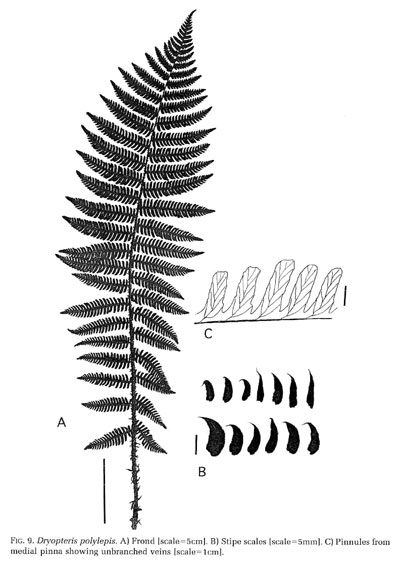| Dryopteris polylepis | ||
|
Etymology
Greek: polu, many + lepis, scale
Description
Rhizome: massive, short, erect, bearing more than ten suberect or ascending fronds in a whorl, scaly.
Frond: 60 cm high by 18 cm wide, deciduous, monomorphic, blade/stipe ratio: 4:1. Stipe: grooved, scales variable, narrowly lanceolate to long-ovate, entire or with filamentous projections at margin, blackish brown to black, vascular bundles: 3-7 in a c-shaped pattern. Blade: 2-pinnate at base, or nearly so, oblanceolate, herbaceous to somewhat leathery, rachis scaly, like stipe but lighter, costa scales similar, hairy scales on upper surface and membranous small scales on lower surfaces. Pinnae: 26 to 28 pair, sessile, lowest pinae gradually shortened to 4-5 cm; pinnules narrowly oblong to linear, falcate, moderately acute to round at apex, often more than 5 mm long and narrow; costae grooved above, continuous from rachis to costae; margins minutely dentate; veins simple, unforked except for the first lower pinnule of the lowest pinnae. Sori: round, large, 3-5 per pinnule, marginal, indusium: entire, gray-brown, thick, at a sinus, sporangia: brownish. Culture
Habitat: on humus-rich floor of temperate forests.
Distribution: Japan, Korea, China.
Hardy to -20�C, USDA Zone 6.
Distinctive Characteristics
veins forking only on the first lower pinnule of the lowest pinnae and the narrow pinnules
Synonyms
Aspidium polylepis Franch. et Sav. Nephrodium polylepis Bak. |
|
|
